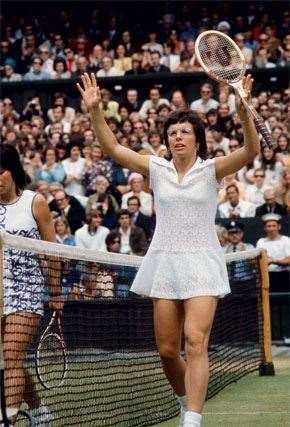Billie Jean King didn’t just liberate women – she liberated the game of tennis.
Billie Jean King didn’t just liberate women – she liberated the game of tennis.
 Conquering the court was easier than conquering chauvinism for Billie Jean King.
Conquering the court was easier than conquering chauvinism for Billie Jean King.Images: Getty Images
There was a time when Billie Jean King was always in the news. After all, she won a total of 12 grand slam singles titles, including six Wimbledons, a total of 39 grand slam titles altogether, and had celebrated rivalries with Margaret Court, Chris Evert and Martina Navratilova. She was also at the centre of a widely publicised “palimony” suit in 1981, when she split with long-time lover, Marilyn Barnett, “coming out” at the same time.
But none of this makes Billie Jean a sporting innovator. From the start, King, born Billie Jean Moffitt in 1943, was an intense, smart and strong character, and The Establishment foolishly gave her all sorts of reasons to oppose it. King didn’t like losing. She described herself not as competitive, but as a perfectionist, and heaven help anyone who upset her notion of what perfection should be.
Though she became famous in the 1970s as an advocate of the women’s game, it was not her sole preoccupation. The feisty, bespectacled champion had taken on the formidable US Lawn Tennis Association before the “Open” era began in 1968. At the time, King paid her way by working as a playground instructor. She was one of the first to popularise the use of the word “shamateurism” to describe the corrupt practice of officially encouraging lilywhite sport while covertly greasing the palms of top players.
Coming as it did at the start of the professional era, her stance didn’t only set the tone for better pay, but for equality. She believed tennis players, men and women, were sport’s second-class citizens. “I’d like to see tennis get out of its ‘sissy’ image and see some guy yell, ‘Hit it, ya bum’ ... a game you don’t have to have a lorgnette or sash across your tuxedo to get in to watch.”
Having done much to gain mainstream acceptance for tennis, King felt the place of women was an issue. She was paid $15,000 dollars less than the men’s winner, Ilie Nastase, when she won the 1972 US Open. King was a poster girl for women the world over. Along with Greer and Friedan, she’d become the face of feminism. She was a winner. She drew crowds. If Billie Jean threatened to withdraw from a tournament, it was box-office disaster. That’s precisely what she declared she’d do if the women’s winner wasn’t paid the same amount in 1973. That year, the US Open became the first grand slam tournament to allocate equal pay to men and women.
In 1973, responding to taunts from former Wimbledon champion and world number-one Bobby Riggs, King took up the cudgel for women’s tennis. Riggs, at 55, had claimed that women’s tennis was so weak even he could beat the top players. He then proved it by belting Australia’s fading Margaret Court 6-2, 6-1 in a challenge match. Women were incensed at Riggs’ behaviour after the match, especially his description of himself as a “hustler”. Not only could he out-muscle the women, but – apparently – he could outsmart them as well. That was enough for King.
She felt compelled not only to answer Riggs’ challenge, but to win. Putting unbelievable pressure on herself, she publicly stated that this was an important day for women the world over. Later on, she was to say that she believed a loss would “set us back 50 years ... It would ruin women’s tennis and affect all women’s self-esteem.”
"The match, famously billed “The Battle of the Sexes”, attracted 30,500 people and was televised in 37 countries. King triumphed over the self-proclaimed “chauvinist” 6-4, 6-3, 6-3.
King then led the rebel professional women’s tournament, the Virginia Slims, and was criticised by The Establishment for putting monetary interests ahead of the game. But King, who’d taken on injustice most of her sporting life, met such opposition with calm resolve: “I tried not to get upset with them. Forgiveness is important. Our job was to have one voice and win them over.”
She became first president of the Women’s Tennis Association while still playing in 1974, and founded World Team Tennis the same year. She also founded WomenSports magazine with her then husband, Lawrence King, and the Women’s Sports Foundation.
On the court and off, King was at her best in the trenches. Her greatest contemporaries – Navratilova, Evert, Wade, Court – all counted her as the toughest and most indomitable spirit in tennis, no matter what the situation. She didn’t just turn things around, she made sure they stayed that way. Her contemporary Rosie Casals said, “No matter how far down you got her, you never could be sure of beating her.”
Even King wouldn’t think of a more apt tribute.
– Robert Drane
Related Articles

Feature Story: Moving the Needle

The Aussies at The Open













